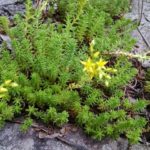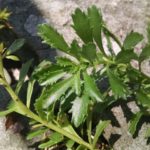 In my last blog post I discussed the succulent plants known to botanists as Sempervivum (Hens-and-Chicks) and Hylotelephium (pronounced ‘high-low-tele-fee-um’). Hylotelephium plants, such as the popular variety ‘Autum Joy’, used to be known botanically as Sedum. This week I will discuss the true Sedums, known botanically as Sedum. Sedums are wonderful plants for Catskills gardens.
In my last blog post I discussed the succulent plants known to botanists as Sempervivum (Hens-and-Chicks) and Hylotelephium (pronounced ‘high-low-tele-fee-um’). Hylotelephium plants, such as the popular variety ‘Autum Joy’, used to be known botanically as Sedum. This week I will discuss the true Sedums, known botanically as Sedum. Sedums are wonderful plants for Catskills gardens.
Sedums are easily distinguished from Hylotelephium plants because they have little branching stems that root as they touch the ground, while Hylotelephium plants grow from the center, sending out longer stems which may flop onto the ground but generally don’t set root. Hylotelephium plants grow in a distinct clump, but Sedum plants have a carpet-like growth. This type of growth habit makes true sedums very good for use in the garden as ground cover.
There are over 450 species of Sedum found in nature, and countless garden varieties. The attractive flowers come in pink, yellow or white. Foliage can be deep gray-blue to yellow-green to white-variegated to red-bronze. The great amount of variation in leaf shape also contributes to the countless garden varieties. The following gallery of sedums illustrate some that grow well in gardens here in the Catskills.
 Sedum acre is a common variety which is brittle and breaks easily. It readily spreads when the fragments set root and start new plants.
Sedum acre is a common variety which is brittle and breaks easily. It readily spreads when the fragments set root and start new plants.
Sedum kamschaticum is one of the most common varieties of sedum.
 Sedum kamschaticum floriferum is a variety of Sedum kamschaticum with narrower, toothed leaves.
Sedum kamschaticum floriferum is a variety of Sedum kamschaticum with narrower, toothed leaves.
Sedum sarmentosum is yellow-green and is another very vigorous sedum.
Known either as Sedum reflexum or Sedum rupestre, this species comes in at least three varieties,
 Sedum dasyphyllum is truly minute, the plant body is about a half inch in height; the flowering stalks are up to 2 inches tall.
Sedum dasyphyllum is truly minute, the plant body is about a half inch in height; the flowering stalks are up to 2 inches tall.
 Sedum album is commonly called Baby Toes because of the oval-cylindrical leaf shape. It bears white flowers It often develops a fair amount of reddish tint when growing in the most exposed sites.
Sedum album is commonly called Baby Toes because of the oval-cylindrical leaf shape. It bears white flowers It often develops a fair amount of reddish tint when growing in the most exposed sites.
Sedum ternatum a native of the southeastern U.S.; its flowers are white and appear several weeks earlier than most other sedums; its leaves are thicker and stiffer than other sedums with similarly shaped leaves.
 Sedum spurium is another very popular species which has several named varieties. This is the original variety with plain green leaves.
Sedum spurium is another very popular species which has several named varieties. This is the original variety with plain green leaves.
This variety Sedum spurium ‘Tricolor’ has white variegation; the leaves often develop a pink tinge when exposed to full sun.







